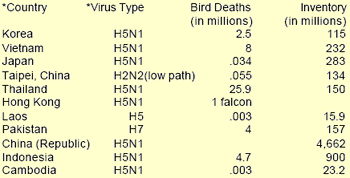



International Egg and Poultry Review
By the USDA's Agricultural Marketing Service - This is a weekly report looking at international developments concerning the poultry industry, this week looking at the bird flu in Asia.
Bird Flu in Asia
In a news release on February 2, 2004 the Food and Agriculture Organization of the United Nations estimated more than 45 million birds had been culled due to avian influenza, excluding China. Asia has an estimated chicken population of 7 billion birds.
Indonesia says Newcastle accounted for 60 percent of the loss, and a combination of avian influenza and Newcastle accounted for 40 percent of the loss.

*OIE (World Organization for Animal Health)
Poultry in country and bird deaths are estimates from various news wires
Source: OIE/WHO/FAO/Various News Wires
International Meeting on Avian Influenza in Asia
An international meeting held in Bangkok, Thailand January 28, 2004
addressed the spread of highly pathogenic avian influenza in Asia.
Agriculture and health officials from 13 countries/economies and experts
from the World Organization on Animal Health (OIE), the World
Health Organization (WHO), and the Food and Agriculture Organization
(FAO) attended the closed door meeting.
WHO experts stressed that mass slaughter of infected birds is a key
for controlling the epidemic's spread. Participants pledged to increase
surveillance, set up a regional veterinary network, develop low cost
tests, and to use vaccination and antiviral drugs. An FAO spokesman
noted the need to modernize poultry farming and to restrict live animal
markets.
A joint statement issued at the end of the meeting said culling of infected animals was the most effective method to contain the virus. The statement was endorsed by public health and agriculture ministers from Cambodia, China, Indonesia, Japan, South Korea, Laos, Malaysia, Singapore, Thailand, the United States, and Vietnam, and representatives of the OIE, WHO, and the FAO.
Source: Various News Wires
Countries Standing to Gain
In light of the health outbreaks of mad cow disease and avian influenza, many Asian and Middle Eastern countries are looking abroad to fill their meat needs and numerous others are jumping at the opportunity. A few such countries are Brazil, India, and Australia.
Brazil recently sent a delegation of government officials and privatesector leaders to Japan to discuss possible trading with the emphasis on the safety of Brazil's products. The group expounded upon measures such as intensified controls at airports, ports, and baggage, as well as the enforced limiting of visitors to local poultry farms. The group will also visit South Korea and Taiwan.
Japan, like many other Asian countries, is suffering a meat shortage as it has placed bans on its' number 1 and 3 poultry importers, Thailand and China respectively, as well as on one of its' top two beef importers, the U.S. The country has lost more than 25% of its' domestic beef demand and 17% of its' domestic chicken demand. Demand for Brazilian chicken is rising and dragging prices with it as was seen in Japan over the course of past week at a 44.7% increase.
All in all Brazil's exports are expected to rise 10% in 2004 from a record 1.92 million tons last year, growing to U.S.$5.5 billion. In 2003, Brazil exported 1.9 billion tons of chicken valued at U.S.$1.8 billion to 120 countries including: Uzbekistan, Ukraine, Lebanon, Lithuania, Bosnia,
Hungary, Canada, Venezuela, Cuba, and many more. Members of Brazil's delegation stated last week in its' meetings with Japan that Brazil is prepared to increase its' exports of both chicken and beef, but neglected to give a specific figure.
Source: Various News Wires
Brazil Continues to Expand Production Through 2004 Fueled By Strong Domestic and Foreign Demand

Source: USDA FAS/USDA FAO
To view the full report, including tables please click here
Source: USDA's Agricultural Marketing Service - 3rd February 2004








